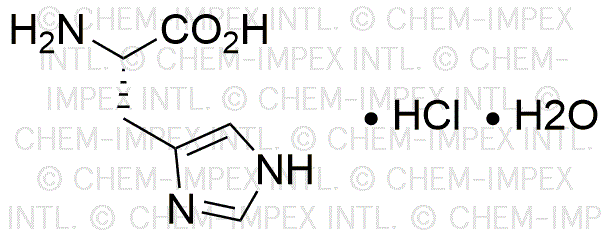L-Histidine hydrochloride monohydrate is widely utilized in research focused on:
- Biotechnology: It serves as a key component in cell culture media, promoting cell growth and enhancing protein production in biopharmaceutical manufacturing.
- Pharmaceuticals: This compound is used in the formulation of various medications, particularly those targeting metabolic disorders, due to its role as an essential amino acid.
- Food Industry: It acts as a food additive and preservative, improving the nutritional profile of products and extending shelf life by preventing spoilage.
- Nutritional Supplements: Commonly found in dietary supplements, it supports muscle recovery and immune function, making it popular among athletes and health-conscious consumers.
- Research Applications: In scientific studies, it is used as a buffer in biochemical assays, helping to maintain pH stability and improve the accuracy of experimental results.
General Information
Properties
Safety and Regulations
Applications
L-Histidine hydrochloride monohydrate is widely utilized in research focused on:
- Biotechnology: It serves as a key component in cell culture media, promoting cell growth and enhancing protein production in biopharmaceutical manufacturing.
- Pharmaceuticals: This compound is used in the formulation of various medications, particularly those targeting metabolic disorders, due to its role as an essential amino acid.
- Food Industry: It acts as a food additive and preservative, improving the nutritional profile of products and extending shelf life by preventing spoilage.
- Nutritional Supplements: Commonly found in dietary supplements, it supports muscle recovery and immune function, making it popular among athletes and health-conscious consumers.
- Research Applications: In scientific studies, it is used as a buffer in biochemical assays, helping to maintain pH stability and improve the accuracy of experimental results.
Documents
Safety Data Sheets (SDS)
The SDS provides comprehensive safety information on handling, storage, and disposal of the product.
Product Specification (PS)
The PS provides a comprehensive breakdown of the product’s properties, including chemical composition, physical state, purity, and storage requirements. It also details acceptable quality ranges and the product's intended applications.
Certificates of Analysis (COA)
Search for Certificates of Analysis (COA) by entering the products Lot Number. Lot and Batch Numbers can be found on a product’s label following the words ‘Lot’ or ‘Batch’.
*Catalog Number
*Lot Number
Certificates Of Origin (COO)
This COO confirms the country where the product was manufactured, and also details the materials and components used in it and whether it is derived from natural, synthetic, or other specific sources. This certificate may be required for customs, trade, and regulatory compliance.
*Catalog Number
*Lot Number
Safety Data Sheets (SDS)
The SDS provides comprehensive safety information on handling, storage, and disposal of the product.
DownloadProduct Specification (PS)
The PS provides a comprehensive breakdown of the product’s properties, including chemical composition, physical state, purity, and storage requirements. It also details acceptable quality ranges and the product's intended applications.
DownloadCertificates of Analysis (COA)
Search for Certificates of Analysis (COA) by entering the products Lot Number. Lot and Batch Numbers can be found on a product’s label following the words ‘Lot’ or ‘Batch’.
*Catalog Number
*Lot Number
Certificates Of Origin (COO)
This COO confirms the country where the product was manufactured, and also details the materials and components used in it and whether it is derived from natural, synthetic, or other specific sources. This certificate may be required for customs, trade, and regulatory compliance.

